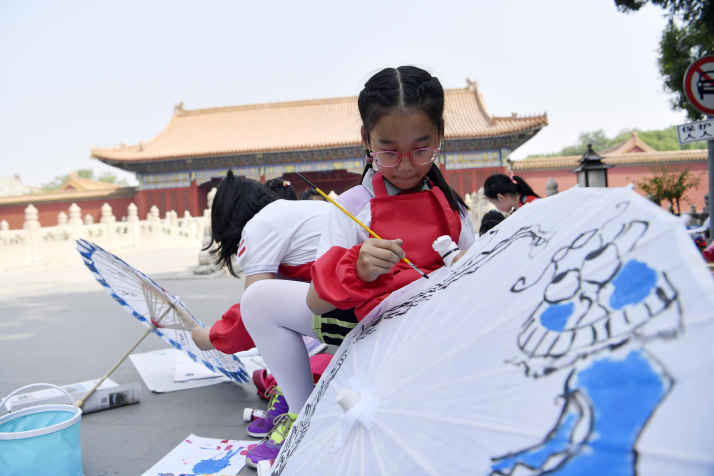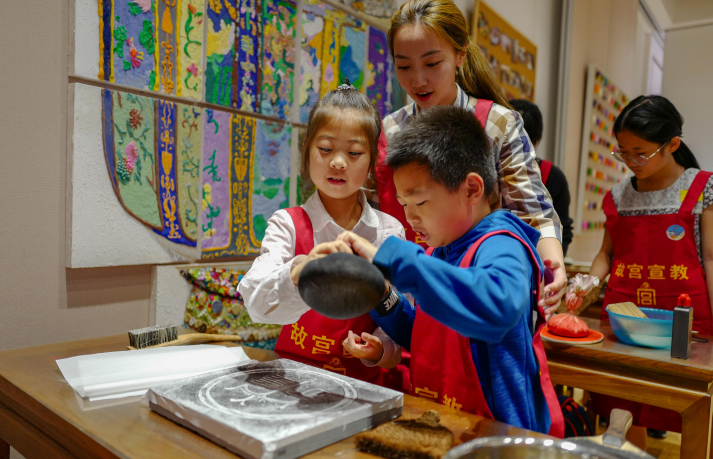|
||||||||||
| Home Nation World Business Opinion Lifestyle ChinAfrica Multimedia Columnists Documents Special Reports |
|
||||||||||
| Home Nation World Business Opinion Lifestyle ChinAfrica Multimedia Columnists Documents Special Reports |
| ChinAfrica |
| Giving New Life to Antiquities |
| China's Palace Museum makes its treasures available as popular merchandise to keep relevant |
| By Li Jing | VOL.11 January ·2019-01-15 |

A whopping 87,674 registered users and 120,000 copies sold in 38 days, with a revenue of 20.2 million yuan ($2.93 million). These are some of the figures that illustrate the runaway success of the book Migong, Palace of Puzzles, on Modian, a crowdfunding platform of the cultural and creative industry in China. The book has not only set a new record among publishing projects for crowdfunding in China, but also broke records for similar products on international platforms Kickstarter and Indiegogo.
As the first interactive game book published by Palace Museum Press, Migong, Palace of Puzzles includes more than 30 puzzles to test readers' knowledge related to the history and culture of the Forbidden City and its vast collection. By successfully solving puzzles using their mobile phone app, users can discover some of the many "treasures" hidden in the book. Readers can also continue their treasure-hunt adventure on the spot in the Palace Museum, using their mobile phones.
According to Palace Museum Press, this innovative book that combines both online and offline experience is to be available for sale in China in January 2019. But already, demand has exceeded their wildest expectations: More than 120,000 copies have already been ordered during the crowdfunding period.
Migong, Palace of Puzzles is but one of the many cultural and creative products related to the Palace Museum that has been put out on the market in recent years. Indeed, many new products useful for daily life, such as calendars, bags, scarves and umbrellas, all decorated with the images of some of the treasures of the Palace Museum, have helped this museum regain its due place in modern society.
The key is usefulness
The Palace Museum is an institution that aims not only to protect ancient buildings dating from the Ming and Qing dynasties (1368-1911), but also to conserve, exhibit and study China's ancient cultural treasures. At the moment, its collections include more than 1.8 million pieces.
"If visitors can't appreciate the collections properly, then there is no point in being proud to have the museum with the largest number of Chinese cultural treasures in the world," said Shan Jixiang, Director of the Palace Museum, who has repeatedly stressed the need for museums "to restore the dignity" of the ancient relics.
With this goal in mind, he intends to "bring the museum into people's lives." At present, all ticket purchases in the Palace Museum are made online and a digital museum has been opened to the public, in which visitors can find information on all the collections. Many cultural products sold by the Palace Museum also play an important role to achieve this objective.
"We need to study the life of our public and understand what they really need. Therefore, we always take into consideration the usefulness of our products. The combination of culture and utility allows the public to understand culture by using the products, in order to spread traditional Chinese culture," explained Chen Fei from the Cultural Services Center of the Palace Museum.
Take for example the dragon robe of the ancient Chinese emperors. Its elegant design can be transformed into a mobile phone case, a silk scarf or a fan. The door of a palace of the Forbidden City can be used as a bottle opener. The famous painting Along the River During the Qingming Festival of the Song Dynasty (960-1279) can be used to decorate scarves, puzzles and notebooks. Many other everyday-life products are also available, such as dolls of emperors and queens, T-shirts, wallets and socks.
Their excellent quality is another reason which explains why such products are so popular. Indeed, they are often offered as official gifts to foreign leaders during their state visits to China.

Children learn to make Chinese traditional stone rubbings in the Palace Museum (XINHUA)
Diversified methods
The Palace Museum's diversified approach to promotion also made it possible for its cultural and creative products to find their place in the public's daily life. The museum was quick to take advantage of the Internet, where it sells and promotes its products via a number of e-commerce platforms. Currently, it has its own stores on Taobao, Tmall and JD. On Tmall alone, the number of monthly transactions now exceeds 42,000.
Technology can also be used to create new products. The Palace Museum has already developed a variety of games and mobile phone apps, such as A Day of the Emperor, which made it possible for many young users to discover China's traditional culture. In 2016, the Palace Museum and Chinese tech giant Tencent launched a series of mobile games and emoticons using the theme of the Palace Museum.
The Palace Museum is also exploring other channels of cooperation. For example, it recently made a deal with Daoxiangcun, Beijing's oldest pastry shop, to jointly launch a set of limited-edition of moon cakes. An agreement with China Minsheng Bank has made it possible to offer credit cards decorated with elements from the Palace Museum. The Palace Museum also collaborates with Harper's Bazaar magazine to put out silk scarves, necklaces and handbags.
"The museum must learn how to use a variety of diverse methods to better share traditional culture, allowing the rich cultural heritage of the Palace Museum to take on a life of its own. The most important thing for a museum is to allow its cultural resources to find their place in people's lives," said Shan.
Giving back to society
The commercial success of many of the products sold by the Palace Museum raises another question: Where do the profits go? In education, according to Shan Yuxiang.
Since 2004, the Palace Museum has opened its doors free of charge to all primary and secondary school students. Moreover, in 2016, it built and opened its very own education center. With the aim of providing a dedicated open space for students to carry out research and education projects, the center covers approximately 800 square meters and can accommodate more than 200 people simultaneously.
In 2018, more than 60,000 educational activities were organized with the participation of more than 410,000 people, most of whom are students. Under the guidance of their instructors, students can immerse themselves in the charm of traditional Chinese culture by engaging in various activities, such as drawing their very own dragon robe or making necklaces like those worn by government officials in ancient China.
"All those events are offered free of charge. We invest a big part of our income in children's activities. We firmly believe that this will allow our new generation to better appreciate Chinese culture," said Shan.
(Comments to lijing@chinafrica.cn)
|
||||||||||||
| About Us | Contact Us | Advertise with Us | Subscribe |
| Copyright Beijing Review All rights reserved 京ICP备08005356号-5 京公网安备110102005860号 |